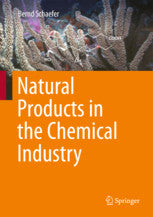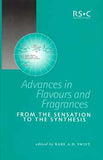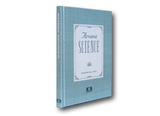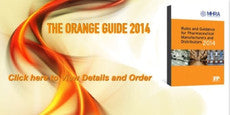Natural Products in the Chemical Industry by Schaefer, Bernd
- First book covering especially natural products used in industrial chemistry
- Offers a deep insight into modern research and development of complex molecules
- Includes aspects of “green chemistry” and elegance of industrial product synthesis
Natural Products in the Chemical Industry is not a conventional textbook, but rather an invitation to join an entertaining journey that takes you into the fascinating world of natural products. This book features diverse compound classes from a number of areas: colourants, fragrances and flavourings, amino acids, pharmaceuticals, hormones, vitamins and agrochemicals. Whether you are a teacher or a scholar, an undergraduate or graduate student, a professional chemist in industry or academia, or someone just interested in natural sciences, this book allows you to be inspired and entertained by facts and information along with enjoyable anecdotes, historical, economic, political, biological and social considerations. Experts in the field can have a pleasurable time cruising through captivating synthesis methods, which enable the generation of complex molecules on industrial scale.
Preface to the second edition VII
Content . . . . . . . . . . . . . . . . . . . . . . . . . . . . . . . . . . . . . .X
1 Introduction
1.1 Important Fields of Application for Natural Product Chemistry
1.1.1 Population Growth
1.1.2 Nutrition
1.1.3 Healthcare
1.1.4 Fragrances
1.1.5 Colourants
1.1.6 Inspiration for Innovations
1.2 Natural Product Chemistry in the Chemical Industry
1.2.1 A Short Selection of Elegant Syntheses
Summary in Bullet Points
References .
2 Colourants
Summary in Bullet Points
2.1 Indigo
2.1.1 Introduction
2.1.2 Structure Determination
2.1.3 Biosynthesis
2.1.4 Industrial Synthesis
2.1.5 Modern Lab-scale Indigo Synthesis
2.1.6 Industrial Dyeing Process . . . . . . . . . . . . . . . . . .
2.1.7 Outlook
Summary in Bullet Points
2.2 Tyrian Purple
2.2.1 Introduction
2.2.2 Biosynthesis
2.2.3 Structure Determination
2.2.4 Technical Application
2.2.5 Newer Developments
Summary in Bullet Points
2.3 Alizarin
2.3.1 Introduction
2.3.2 Structure Determination
2.3.3 Industrial Synthesis
2.3.4 Industrial Dyeing Process
2.3.5 Impact on the Development of the “Young” Chemical Industry
2.3.6 Modern Developments
Summary in Bullet Points
References
3 Flavours and Fragrances
Summary in Bullet Points
3.1 Damascone
3.1.1 Rose Scent from Rose Flowers
3.1.2 Biogenesis of Damascone
3.1.3 Synthesis of Damascone .
3.1.4 Industrial Process
Summary in Bullet Points
3.2 Ionone
3.2.1 Violet and Iris Oil
3.2.2 Biosynthesis
3.2.3 Industrial Syntheses
3.2.4 Enantiomerically Pure Products
3.2.5 Importance for the Fragrance Industry
Summary in Bullet Points
3.3 Jasmonoids
3.3.1 Occurrence in Nature
3.3.2 Use in Perfumery
3.3.3 Nomenclature and Structure-Activity Relationships
3.3.4 Biological Properties
3.3.5 Biosynthesis
3.3.6 Chemical Syntheses
3.3.7 Stereoselective Syntheses
3.3.8 Industrial Syntheses
3.3.9 Magnolione®
Summary in Bullet Points
3.4 Menthol
3.4.1 Biosynthesis
3.4.2 Structure and Activity
3.4.3 Industrial Syntheses
3.4.4 Uses of Menthol
Summary in Bullet Points
3.5 Vanillin
3.5.1 Occurrence
3.5.2 Odour and Taste
3.5.3 Chemical Syntheses
3.5.4 Modern Developments
3.5.5 Applications
Summary in Bullet Points
3.6 Muscone
3 . 6 . 1 Natural Sources
3 . 6 . 2 Structure Determination
3 . 6 . 3 Biosynthesis
3 . 6 . 4 Surrogates
3 . 6 . 5 Historical Synthesis of Macrocycles
3 . 6 . 6 Syntheses of Exaltone
3 . 6 . 7 Syntheses of Racemic Muscone
3 . 6 . 8 Syntheses of Civetone
3 . 6 . 9 Syntheses of Exaltolide
3 . 6 .10 Enantioselective Syntheses of Muscone
3 . 6 .11 Animal Fragrances
Summary in Bullet Points
3 . 7 Ambrox®
3 . 7 . 1 History of the Scent
3 . 7 . 2 Constituents of Ambergris
3 . 7 . 3 Partial Syntheses
3 . 7 . 4 Total Syntheses
3 . 7 . 5 Polyene Cyclisations
3 . 7 . 6 Enzymatic Polyene Cyclisation
3 . 7 . 7 Superambrox
3 . 7 . 8 Commercial Use
Summary in Bullet Points
References
4 Amino acids
4 . 1 Biological Nitrogen Fixation
4 . 2 Artificial Nitrogen Fixation
4 . 3 Biosynthesis
4 . 4 Industrial Synthesis
4 . 4 . 1 Protein Hydrolysis
4 . 4 . 2 Chemical Synthesis
4 . 4 . 3 Enzymatic Methods
4 . 4 . 4 Separation of Enantiomers by Crystallisation
4 . 4 . 5 Fermentation Methods
4 . 5 ( D)-Amino Acids
4 . 6 Aspartame
4 . 7 New Developments
4 . 7 . 1 Amidocarbonylation
4 . 7 . 2 Enantioselective Synthesis
4 . 7 . 3 Enantioselective Strecker Synthesis
4 . 8 The Maillard Reaction 202
Summary in Bullet Points
References
5 Pharmaceuticals
Summary in Bullet Points
5.1 ACE Inhibitors
5.1.1 Physiological Fundamentals
5.1.2 History of Discovery
5.1.3 Syntheses
5.1.4 Second-Generation ACE Inhibitors
5.1.5 X-ray Structure Analysis of ACE
5.1.6 Economic Relevance
5.1.7 Recent Developments
Summary in Bullet Points
5.2 β-Lactam Antibiotics
5.2.1 Introduction
5.2.2 Classification
5.2.3 Mode of Action
5.2.4 The Discovery of Penicillin
5.2.5 First Total Synthesis
5.2.6 The Discovery of Cephalosporins
5.2.7 First Total Synthesis
5.2.8 Biosynthesis
5.2.9 Biotechnological Syntheses .
5.2.10 Carbapenem Antibiotics
5.2.11 Newer β-Lactam Antibiotics
5.2.12 Outlook .
Summary in Bullet Points
5.3 Opiates
5.3.1 History of the Poppy
5.3.2 Physiology and Pharmacology
5.3.3 Botany and Cultivation
5.3.4 Ingredients of Poppy
5.3.5 Biosynthesis
5.3.6 Preparation of Opium and Opium Alkaloids
5.3.7 Discovery of Morphine
5.3.8 The First Enantioselective Total Synthesis of Morphine
5.3.9 Partial Synthesis of Opioids with a Morphine Skeleton
5.3.10 Total Synthesis of Opioids with a Morphinan-like Skeleton
5.3.11 Totally Synthetic Opioids without a Morphinan Structure
5.3.12 Closing Remarks
Summary in Bullet Points
5.4 Tetrahydrocannabinol
5.4.1 Botany and Use
5.4.2 The Drug
5.4.3 Biosynthesis
5.4.4 Endocannabinoids
5.4.5 Structure-Activity Relationships
5.4.6 Pharmacology
5.4.7 Chemical Syntheses
Summary in Bullet Points
5.5 Nonsteroidal Anti-Inflammatory Drugs
5.5.1 Biosynthesis of Salicylates
5.5.2 Chemical Synthesis of Salicylic acid
5.5.3 Discovery of Aspirin®
5.5.4 Mode of Action of Aspirin® .
5.5.5 Other Natural Cyclooxygenase Inhibitors
5.5.6 Paracetamol
5.5.7 Pyrazolones
5.5.8 Discovery of the Classical Non-steroidal Anti-inflammatory Drugs
5.5.9 Mode of Action of Competitive COX-Inhibitors
5.5.10 Development of Selective COX-2 Inhibitors
5.5.11 Syntheses of Modern Non-steroidal Anti-inflammatory Drugs
5.5.12 Syntheses of COX-2 Inhibitors
5.5.13 Outlook .
Summary in Bullet Points
5.6 Prostaglandins
5.6.1 Biosynthesis of Eicosanoids
5.6.2 Nomenclature
5.6.3 Pharmacology of Eicosanoids
5.6.4 Partial Synthesis of Natural Products
5.6.5 Total Synthesis of Natural Products
5.6.6 Prostaglandin Derivatives
5.6.7 Prostacyclin PGI2 357 5.6.8 Carbacyclins
Summary in Bullet Points
5.7 Tetrahydrolipstatin
5.7.1 Adiposity
5.7.2 Pharmacology
5.7.3 Biosynthesis 367 5.7.4 Synthesis of the Natural Product
5.7.5 Syntheses of Tetrahydrolipstatin
5.7.6 Concluding Remarks
Summary in Bullet Points
5.8 Taxol ®
5.8.1 Historical Facts about Cancer
5.8.2 Biological Fundamentals
5.8.3 Discovery of Paclitaxel
5.8.4 Paclitaxel from Microorganisms
5.8.5 Total Synthesis
5.8.6 The Paclitaxel Pharmacophore
5.8.7 Manufacturing of Paclitaxel
5.8.8 Outlook
Summary in Bullet Points
5.9 Statins
5.9.1 Discovery of Arteriosclerosis/Atherosclerosis
5.9.2 Pathogenesis of Atherosclerosis
5.9.3 First Treatment Methods for Atherosclerosis
5.9.4 Discovery of HMG-CoA-Reductase Inhibitors (Statins)
5.9.5 Mode of Action and Structure-Activity Relationships
5.9.6 Biosynthesis
5.9.7 Total Synthesis
5.9.8 Industrial Syntheses
5.9.9 Outlook
Summary in Bullet Points
5.10 Artemisinin
5.10.1 History of the Disease
5.10.2 The Pathogenic Agent and its Vector
5.10.3 Malaria Treatment and its History
5.10.4 The Discovery of Artemisinin
5.10.5 Sweet Wormwood (Artemisia annua)
5.10.6 Biosynthesis
5.10.7 Pharmacology of Artemisinin
5.10.8 Total Syntheses
5.10.9 Production
5.10.10 Derivatives
5.10.11 Final Remarks
Summary in Bullet Points
5.11 Caffeine
5.11.1 History
5.11.2 Botany and Occurrence
5.11.3 Structure Determination
5.11.4 Pharmacology
5.11.5 Prebiotic Synthesis
5.11.6 Biosynthesis
5.11.7 Caffeine from Natural Sources
5.11.8 Syntheses
5.11.9 Uses
Summary in Bullet Points
5.12 Nicotine
5.12.1 Historical
5.12.2 Isolation and Structure Determination
5.12.3 Occurrence and Botany . . . . . . . . . . . . .
5.12.4 Biosynthesis
5.12.5 Pharmacology
5.12.6 Detoxification
5.12.7 Nicotinoids – Nicotine-related Natural Products
5.12.8 Varenicline – an Anti-smoking Drug
5.12.9 Chemical Syntheses
5.12.10 Production of Nicotine and Varenicline
Summary in Bullet Points
References
6 Hormones
Summary in Bullet Points
6.1 Steroids and Hormonal Contraceptives
6.1.1 Historic Methods of Contraception
6.1.2 Biological Essentials
6.1.3 Natural Steroids and Steroid Hormones
6.1.4 Biosynthesis
6.1.5 Discovery of Steroid Hormones
6.1.6 Partial Syntheses
6.1.7 Total Syntheses
6.1.8 The Third-Generation “Pill”
6.1.9 Further Developments
6.1.10 Final Remarks
Summary in Bullet Points
6.2 Thyroxine
6.2.1 Iodine Supply
6.2.2 Discovery of Thyroid Hormones
6.2.3 Physiology
6.2.4 Structure-Activity Relationships
6.2.5 Biosynthesis
6.2.6 Hyperthyroidism
6.2.7 Industrial Synthesis
Summary in Bullet Points
6.3 Adrenaline
6.3.1 Discovery of the Hormones of the Adrenal Medulla
6.3.2 Physiology
6.3.3 Biosynthesis
6.3.4 Deactivation
6.3.5 Pharmacology
6.3.6 Structure-Activity Relationships
6.3.7 Adrenergic Drugs
6.3.8 Chemical Syntheses
Summary in Bullet Points
References
7 Vitamins
Summary in Bullet Points
7.1 Vitamin A and Carotenoids
7.1.1 Discovery of Carotenoids
7.1.2 Biosynthesis
7.1.3 The Colours of Carotenoids
7.1.4 Industrial Manufacturing Processes
7.1.5 Modern Trends
Summary in Bullet Points
7.2 Vitamin D
7.2.1 Discovery
7.2.2 Physiology
7.2.3 Industrial Syntheses
7.2.4 New Approaches .
7.2.5 Economic Aspects
Summary in Bullet Point
7.3 Biotin
7.3.1 Demand and Occurrence
7.3.2 Antagonists
7.3.3 Biosynthesis
7.3.4 Biological Function
7.3.5 Chemical Syntheses
7.3.6 Economic Aspects
Summary in Bullet Points
References
8 Agrochemicals
Summary in Bullet Points
8.1 Amino Acid Herbicides
8.1.1 Basta®
8.1.2 Roundup® Summary in Bullet Points
8.2 Strobilurins
8.2.1 Biosynthesis
8.2.2 Biochemical Activity of Strobilurins and Oudemansins
8.2.3 Structure Optimisation
8.2.4 Natural Product Syntheses
8.2.5 Industrial Syntheses of Active Compounds
Summary in Bullet Points
8.3 Pyrethroids
8.3.1 Biosynthesis
8.3.2 Structure Determination
8.3.3 Structure-Activity Relationships
8.3.4 Synthetic Pyrethroids
8.3.5 The Alcohol Moiety of Synthetic Pyrethroids
Summary in Bullet Points
8.4 Neonicotinoids
8.4.1 Insecticides Acting at the Cholinergic Synapse
8.4.2 Physiology and Pharmacology
8.4.3 Discovery of the Neonicotinoids
8.4.4 Selectivity: Insects versus Vertebrates
8.4.5 Industrial Syntheses
8.4.6 Economic Importance
8.5 Pheromones
8.5.1 Discovery
8.5.2 Examples
8.5.3 Biosynthesis
8.5.4 Stereochemistry and Biological Action
8.5.5 Communication
8.5.6 Applications in Plant Protection
8.5.7 Chemical Synthesis
Summary in Bullet Points References
List of Abbreviations
Directory of Illustrations
Subject Index
This book
· deals with the manufacturing of larger quantities of complex molecules (asymmetric and heterocyclic compounds, polycyclic structures, macrocycles and small rings)
· displays all reaction schemes in colour, which makes them easy to read
· highlights aesthetics and elegance in modern industrial organic chemistry
ABOUT THE AUTHOR :
Bernd Schaefer studied chemistry in Kaiserslautern and received his PhD for research on metal-catalysed, stereoselective cycloadditions of methylenecyclopropanes to electron-deficient olefinsfrom the Max-Planck-Institut für Kohlenforschung in Mülheim, Germany. His professional career at BASF covers research and development in the areas of plant protection, pharmaceutical chemistry and fine chemicals. In 2000, Bernd Schaefer was appointed lecturer and in 2009 Honorary Professor at the Ruprecht-Karls-Universität in Heidelberg. Besides natural product chemistry, his special areas of interest include catalysis and enantioselective synthesis.
This work was carefully translated by David Smith and Bernd Janssen.
REVIEWS :
“Schaefer … has written an outstanding text for anyone with a chemistry background who enjoys learning about and understanding the connection between the historical and present-day pharmaceutical, fine, and specialty chemical industries. … Summing Up: Recommended. Upper-division undergraduates, graduate students, researchers/faculty, and professionals/practitioners.” (L. J. Liotta, Choice, Vol. 53 (1), September, 2015)
“The author describes the motivations for industrial chemistry, and explains the importance of cost-efficient total syntheses. … this book is highly recommended … . We are sure that this book will have a strong impact, considering on the one hand the revival of interest in natural products in the age of multi-resistant human and plant pathogens, and on the other hand the emphasis on bio-economy in various areas of life sciences and biotechnology.” (Frank Surup and Marc Stadler, Angewandte Chemie International Edition, Vol. 54 (31), July, 2015)
“This book describes natural products chemistry with the eyes of an industrial chemist. … Each chapter is abundantly illustrated and very agreeable to read. … The book is very pleasant to read, instructive and very didactic. The study of various retrosynthetic analyses … will be of great interest to undergraduate students. … This book should be part of any chemist’s library who is interested in natural product chemistry.” (Prof. Dr. Paul Knochel, Synthesis, Vol. 47,2015)
“The textbook “Natural Products in the Chemical Industry” from Bernd Schaefer comprises a fresh and holistic overview of the economically important natural products such as colorants, fragrances and flavorings, amino acids, pharmaceuticals, hormones, vitamins and agrochemicals. ... To sum up, the author managed to give a broad overview of natural products for the educated organic chemist, who may have heard and learned several aspects throughout his studies and beyond, which come all together in this book. The monograph is also of high use for those teaching organic chemistry, by providing many interesting examples, anecdotes, and historical backgrounds to accompany the usual mechanism-based learning.” (Prof. François Diederich, ETH Zurich)
“One has to congratulate Bernd Schaefer for this extraordinary achievement. His book holds a unique position among the many publications on natural products chemistry, providing a view from an industrial perspective. It is a pleasure to read through the different chapters, which are all written in a very clear and lively style. The graphically attractive layout with rich illustrations animates the reader to browse through the book. The author has done a superb job in covering all aspects of natural products chemistry including historical aspects and the impact on medicine and society. His book will serve as a rich source of inspiration for students, rese archers, and academic teachers.” (Prof. Andreas Pfaltz, University of Basel, June 2015)
“Bernd Schaefer’s sparkish enthusiasm for the topic electrifies the readers. This book is a unique and definitive resource and an absolute must-have for all chemists, interested in synthesis of natural products.” (Prof. Benjamin List, Max-Planck-Institut für Kohlenforschung, Germany, May 2015)
“This book would be especially beneficial to the graduate students who are majoring organic and medicinal chemistry, not to mention of the people who are already in the chemical industry as well as in academia of chemical science.” (Prof. Sangho Koo, Myong Ji University, Korea, April 2015)
“This unique book is a labor of love of Dr. Bernd Schaefer of the BASF who has an immense appreciation of the evolution of the field of natural products and their chemistry from discovery, to synthesis, and to industrial production. If you are a student, a teacher, a chemist in industry or academia who maintains a thirst for scientific knowledge and looking for fun with science, you may want to consider placing it on your night stand.” (Prof. Victor Snieckus, Queen’s University, Canada, March 2015)


















